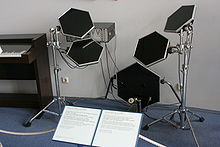Invisible Touch
After taking a break in 1984 for each member to continue his solo career, the band reconvened in October 1985 to write and record Invisible Touch with engineer and producer Hugh Padgham.
The group followed this with a period of inactivity to allow each member to continue their respective solo careers; Mike Rutherford formed his group Mike + The Mechanics and had success with their debut album, Tony Banks concentrated on film scores and released Soundtracks (1986), and Phil Collins released his third solo album No Jacket Required (1985), which was a major worldwide commercial hit.
The group approached the writing sessions for Invisible Touch with a greater sense of confidence, as they had now become a big live act in the US and had reached a new level of commercial success worldwide.
[15] As with Genesis, they entered the studio with no preconceived ideas and developed songs from recorded jams and improvisations,[10] a process Collins compared to as "close to jazz".
[16][17] Collins recalled his impetuous attitude during the writing sessions and suggested bits of songs be pieced together as early as possible, but Banks and Rutherford were reluctant to do so.
In order to capture more of a sound from the Simmons kit rather than feeding it directly into the mixing desk, Padgham also fed the tracks through a mixer and into a PA system before playing it "very, very loud" in the studio.
[10] The lyrics to a track were written after the music was recorded, and were penned by a single member as the group considered the individual had a strong enough direction to carry the song's message through.
[24] The group arranged a greater number of songs for Invisible Touch than before, which required additional time to select which tracks to release.
[26] During the writing sessions Collins realised the band were coming up with fresh and unique material that it had not done before, "which is not easy after 15 albums", and considered them stronger than those on Genesis.
During the session Rutherford began to play an improvised guitar riff with an added echo effect, to which Collins replied with the off-the-cuff lyric, "She seems to have an invisible touch, yeah".
[28] The group wanted to keep the song simple in structure, but thought an eight-bar bridge with a key change and using a sequenced keyboard part complemented the arrangement.
[19] As the band performed "Invisible Touch" in a lower key on tour, Banks had to produce a new sequenced section which was "a real drag" as he was unable to make one as strong as the one on the album.
It encapsulated the whole record and it pushed Genesis into a bit of an R&B area, a little like a Prince thing", and also compared his drumming on the track to American singer Sheila E, of whom he is a fan.
[27] Similar to that of "Invisible Touch", Collins then came out with the word "monkey" and explored it vocally which led to the song's working title to be "Monkey/Zulu".
[27] Rutherford thought the track resembled the "old-style Genesis" as it covers more ground musically with a "fairly involved" instrumental section in the middle.
[29] The lyrics to "In Too Deep" were written by Collins after he was approached to write a song for the soundtrack of the British crime drama film Mona Lisa (1986).
He wrote the chorus during some spare time at a hotel in Sydney, Australia, but he was unable to write verses for it until the band were recording the song in the studio.
[31] Banks gained inspiration for "Anything She Does" from pictures of scantily clad women the band would cut out and place on the wall of their recording studio.
[37] "The Brazilian" is an instrumental based around a sample that Banks had recorded on his E-mu Emulator playing throughout the track, which he achieved by sticking a knife onto the keyboard.
The band had no music prepared and no title at the time of the first briefing, but wanted a design that combined the personality of each member and the outer sleeve to not contain a group photograph.
Baker produced several rough designs and presented them to the band for feedback, by which point some music had been put down and the album's title had been agreed upon.
J. D. Considine gave it a positive review for Rolling Stone, stating that "every tune is carefully pruned so that each flourish delivers not an instrumental epiphany but a solid hook.
[54] Associated Press writer Larry Kilman disagreed, who opened his review with "Genesis have come up with an irresistible Invisible Touch ...
[49] The Rough Guide to Rock describes Invisible Touch as "calculated and oddly emotionless AOR" and stated the hits were "by now barely distinguishable from Collins' songs as a solo artist".
Chick reserved particular praise for "Domino", saying the track "proved a final gasp of brilliance before the blandness of 1991's We Can't Dance and 1997's inexplicable, Collins-less Calling All Stations".
The fact that just the tiniest bit of the 'old' Genesis is discernible in a couple of tracks is the only thing that edges this album a notch ahead of We Can't Dance.
The tour opened with a sold out North American leg which included five nights at Madison Square Garden and also five at the Los Angeles Forum.
[31] It was followed by the band's first and only tour of Australia and New Zealand; the former dates saw Genesis perform "Your Own Special Way" from Wind & Wuthering (1976) with a string section.
[31] The tour ended with four sold out shows at London's Wembley Stadium, totalling 288,000 people in attendance, which set a new record.
[citation needed] Recordings from the tour were released on the live albums The Way We Walk, Volume One: The Shorts (1992) and Genesis Archive #2: 1976–1992 (2000).

